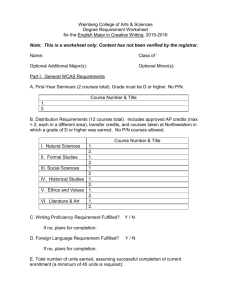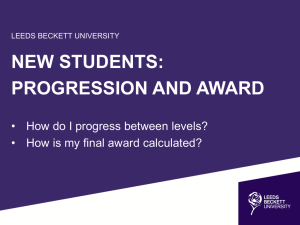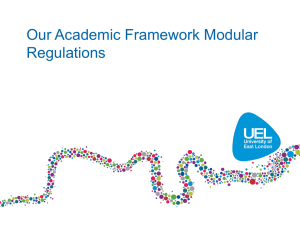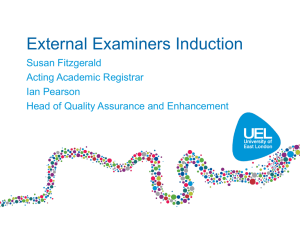Accompanying notes
advertisement
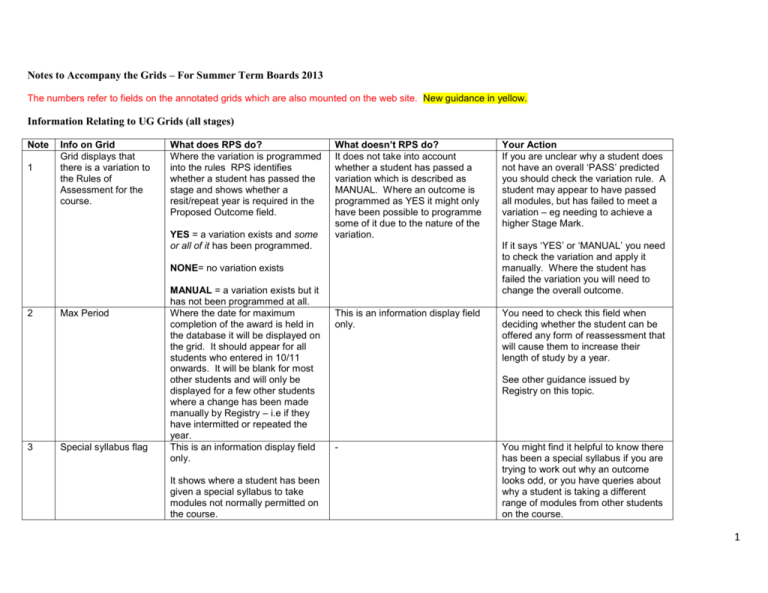
Notes to Accompany the Grids – For Summer Term Boards 2013 The numbers refer to fields on the annotated grids which are also mounted on the web site. New guidance in yellow. Information Relating to UG Grids (all stages) Note 1 Info on Grid Grid displays that there is a variation to the Rules of Assessment for the course. What does RPS do? Where the variation is programmed into the rules RPS identifies whether a student has passed the stage and shows whether a resit/repeat year is required in the Proposed Outcome field. YES = a variation exists and some or all of it has been programmed. What doesn’t RPS do? It does not take into account whether a student has passed a variation which is described as MANUAL. Where an outcome is programmed as YES it might only have been possible to programme some of it due to the nature of the variation. If it says ‘YES’ or ‘MANUAL’ you need to check the variation and apply it manually. Where the student has failed the variation you will need to change the overall outcome. NONE= no variation exists 2 3 Max Period Special syllabus flag MANUAL = a variation exists but it has not been programmed at all. Where the date for maximum completion of the award is held in the database it will be displayed on the grid. It should appear for all students who entered in 10/11 onwards. It will be blank for most other students and will only be displayed for a few other students where a change has been made manually by Registry – i.e if they have intermitted or repeated the year. This is an information display field only. It shows where a student has been given a special syllabus to take modules not normally permitted on the course. Your Action If you are unclear why a student does not have an overall ‘PASS’ predicted you should check the variation rule. A student may appear to have passed all modules, but has failed to meet a variation – eg needing to achieve a higher Stage Mark. This is an information display field only. You need to check this field when deciding whether the student can be offered any form of reassessment that will cause them to increase their length of study by a year. See other guidance issued by Registry on this topic. - You might find it helpful to know there has been a special syllabus if you are trying to work out why an outcome looks odd, or you have queries about why a student is taking a different range of modules from other students on the course. 1 Note 4 Info on Grid Model What does RPS do? Displays the model used for the calculation of the degree classification. It is designed to provide info about 4-yr courses. Model 3 yr = 3 year degree rules What doesn’t RPS do? - Your Action If the result is not what you expect, check whether the correct model has been applied. Check carefully the result for finalists on 4-yr courses. The models assigned for 4 yr rules**: Model 1 Model 2 Model 3 Model 4 **see appendix A for details of the models. For students in the final year of 4-yr courses, Senate agreed that the year abroad marks can be excluded in the degree classification if they have the effect of lowering the classification. RPS has been reprogrammed to take this into account. Where the classification is higher under the 3-yr rules the model will be displayed as model 1 [which excludes yr abroad] and the degree mark changed to match the 40:60 weighting.. 2 5 Mod Level 6 The levels are as follows: – 3 = preliminary stage 4 = Stage One 5 = Stage Two 6 = Stage Three 7 = Masters’ level Module credit field 7 module Aggregate 8 Module status displays: 9 CORE = CORE must be passed Comp = Compulsory to take Opt = Optional module ENr St = Enrolment status for the module. credits are awarded at the level of the module - In the Final Stage you need to pay particular attention to cases where students may have failed their degree because they have not passed 90 credits at level 6 in the final stage. Shows the size of the module taken by the student. - The Board can look back at Stage 2 to see whether they have taken any level 6 credits in that stage which can then be included in the total. - Mark is shown rounded to a whole number. RPS has been programmed to take CORE modules into account as per the structure of the course. They must be passed. - - RPS does not take into account how many times a student has taken the assessment for a module when calculating the student’s result. You must look out for multiple attempts at modules if a student has failed again. It doesn’t do anything as this is only a field displaying information. For students undertaking reassessment the Board will be ratifying the marks for any modules in which the following Enrol codes appear: The status will display once per component where modules are aggregated together. This column shows in which modules students are being reassessed if they are undertaking reassessment without attendance, or repeating modules on a part-time basis. These students can be identified because they will have the following codes in their previous year’s outcome: A= coursework reassessment E=exam reassessment D= both coursework and exam T= taken (i.e the marks were ratified last year) WTEX – undertaking reassessment without attendance RPCR – repeating modules parttime. You can ignore all other Enrol codes for the majority of students who are not undertaking reassessment, but if you are hankering after an explanation 3 – here it is: 10 Reassessment Flag For previous stages a flag will be present to indicate that reassessment took place. The codes are: - C= compulsory H = compulsory with choice of modules B=core G = core with choice of modules F=option This information will be relevant when you are checking how many times a student has taken the assessment for a module, and whether any attempts were first attempts. R -= resit F = first sit V = voluntary reassessment If a student has taken reassessment in a previous stage, the marks for the first attempt will be shown in brackets. 11 ‘C’ field = Credits imposed If a student had been offered a voluntary reassessment and did not take it, the flag will still be shown but there will be no bracketed previous marks. Shows where credits have been imposed. Here are two examples: a) In Stage Two and Three students may have been given a penalty for an academic offence whereby credits are awarded for the component (if passed) but a zero remains on the grid for the work or for the entire module. Where the inclusion of a zero causes the student to get a mark - In cases of academic offences where a zero has been awarded but resubmission has been allowed for credit purposes, the department must ensure that the credits are imposed at the component level if the student passes the module. 4 below 40 in the component, the classification will show as FWC (Fail with credits). This will then count as a Fail under dominant quality rules. 12 *appearing next to module 13 June Notes for Board b) Data from the previous Stage might show that a Stage One student was awarded credits for a fail in a non-core module because the marks were in the permissible range. This shows that the student has received a penalty for an academic offence in the module. Info field only. It doesn’t do anything, this is just for display. For UG students this info would only be relevant if the student was given the chance to resubmit the work during the year and did not do so. In these cases, the student cannot be given a chance to resubmit the work by the Board. These cases are rare, and a note will also have been made in ‘Notes for Board’ field. - Any info for the attention of the board, will go into ‘June Notes for Board’. June Notes for Student 14 The previous year’s module text will now show on the grid for the previous stage. - - 15 Prize field - 16 Ext Circs Prizes awarded will display on the grids for previous years. YES where a form has been Any info which is being given to students after the board for publication on the web, will go into the ‘June notes for students’ field. You may find this information helpful in cases where students are undertaking reassessment out of residence and you want to see whether they were given any special instructions about the assessment. - 5 17 Year credits awarded 18 Proposed Outcomes 19 Outcome Field seen in the grid for previous years’ marks. submitted to Registry No where nothing has been received. C/F showing in a previous year means they were carried forward by the exam board. RPS calculates the year credits awarded according to the credits passed at component level, taking into account any variations. RPS will predict the proposed outcome based on the rules and any variations. - It doesn’t take the following into account: The proposed outcomes are: a) The number of attempts the student has had at the assessment; PASS RESIT REPEATYR WITHDRAW PASSDIST (Pass with Distinction – Stage One only) b) Whether the student can complete his/her studies within the maximum period for the course. This shows what the overall outcome was at the end of the year after the June and, where relevant, September exam boards. Where the student was offered a choice of outcomes, it gives the one the student chose. If it is not showing the full number of credits for the stage and the student appears to have passed all components, please check whether the student has failed a variation for the course which might requiring a pass in the c/wk and/or exam as well as the overall module aggregate. The Exam Board may need to change the overall outcome depending on the student’s individual circumstances. The main ‘Guidance to UG Exam Boards’ gives more information about how to handle difficult cases. c) Whether a student who must withdraw is eligible for an exit award. This is only for display. The most common codes translate as follows: SUCC = Successful, passed 6 everything. SUCX = could proceed to the next stage carrying failed credits RPCR = must retake failed modules by part-time study WTYR = must repeat the year WTYC = must repeat year subject to med cert WTEX = must undertake reassessment without attendance ALTP = must change course (see RPS web page for complete list of codes) 7 Additional Information for Final Year UG Grids Note Info on Grid What does RPS do? What doesn’t RPS do? Your Action 20 Proposed Reassessment RPS checks whether students have met the minimum requirements for an award. If they have, then the field is blank and a degree classification result is given at the bottom of the grid. RPS doesn’t take the following into account: The Exam Board may need to change the overall outcome depending on the student’s individual circumstances. 21 22 Credits awarded on programme ‘At level’ a) The number of attempts the student has had at the assessment; If they have not met the requirements for an award, RPS will propose one of the following outcomes: b) Whether the student can complete his/her studies within the maximum period for the course. Resit Repeat year Withdraw. c) Whether a student who must withdraw is eligible for an exit award. RPS shows the sum of the credits awarded each year for information. Students cannot fail more than 30 non-core credits over the whole course. RPS will propose reassessment if this is the case. RPS counts the credits at the various NQF levels achieved over the whole course. Additionally, for Final Years RPS is checking that they have passed 90 level 6 component credits. If they have not met this requirement, RPS will propose reassessment. The main ‘Guidance to UG Exam Boards’ gives more information about how to handle difficult cases. - If a student has not achieved the number of credits you expect, check that the year totals match what they have passed on the grids – taking into account any variations. On some HCS/SS courses students are given permission to take level 6 credits in Stage Two but this would have been recorded as level 5 credit in the credit count. If students have met all other requirements but appear not to have met the requirement to pass 90 level 6 credits, check the level of the modules they have taken. If they have in fact taken and passed sufficient level 6 modules to be awarded a degree (in either Stage Two or the Final Year) the Board can impose an overall 8 Note Info on Grid What does RPS do? What doesn’t RPS do? 23 Class of Credits Most outcomes are selfexplanatory. - 24 Proposed Result ‘FAIL WITH CREDITS’ means that the student has been given a penalty for an academic offence whereby they resubmit the work for credit purposes only and a zero is awarded for the work or the module. The mark including the zero is used to calculate the stage and degree mark. The component counts as a fail in the ‘dominant quality’ method of calculating the degree result, hence why it is described as a ‘Fail with credits’. RPS runs all the marks through the arithmetic average and dominant quality methods for calculating the degree classification. It displays the higher of the two outcomes if there is a difference. This year RPS will also run all marks through the new degree classification ROA which have just been introduced for students entering the Uni in 12/13. It will present the higher of the outcomes. Your Action degree classification result. - Check the result matches the profile. In cases where a final year student can graduate but has failed a module, the Board must also offer the student to graduate and return for a voluntary reassessment attempt this summer. NB – FOR FINAL YEARS ON 4YEAR COURSESWITH A YEAR ABROAD Senate agreed that the year abroad marks can be excluded in the degree classification if they have 9 Note Info on Grid What does RPS do? the effect of lowering the classification. RPS has been reprogrammed to take this into account. Where the classification is higher under the 3-yr rules the model will be displayed as 3yr and the degree mark changed to match the 40:60 weighting. What doesn’t RPS do? Your Action RPS will also run all the marks through the new degree classification ROA which have just been introduced for students entering the Uni in 12/13. It will present the higher of the outcomes. Registry May 2013 10 Appendix A – note 4 Models used in 4-year courses This table shows the volume of credit allocated to the placement and associated weighting of the placement year, which differentiates the five models MODEL (1) Work-experience or placement year9 (2) Year abroad (Normally as part of a language-related degree) (3) Year abroad (Normally on a degree which is not language-related) (4) Four years studied at Essex VOLUME OF CREDIT ALLOCATED TO THE PLACEMENT, MARKED AS PASS/FAIL 120 MODULES WHICH RECEIVE A MARK WEIGHTING OF YEARS (2-3-4) 0 modules 40%-0%-60% 30 3 modules of 30 marked credits in addition to the placement 2 modules of 30 marked credits in addition to the placement The number of 30credit or 15-credit modules that the course has in conformity with the Rules of Assessment 30%-20%-50% 60 0 30%-20%-50% 30%-30%-40% 11



